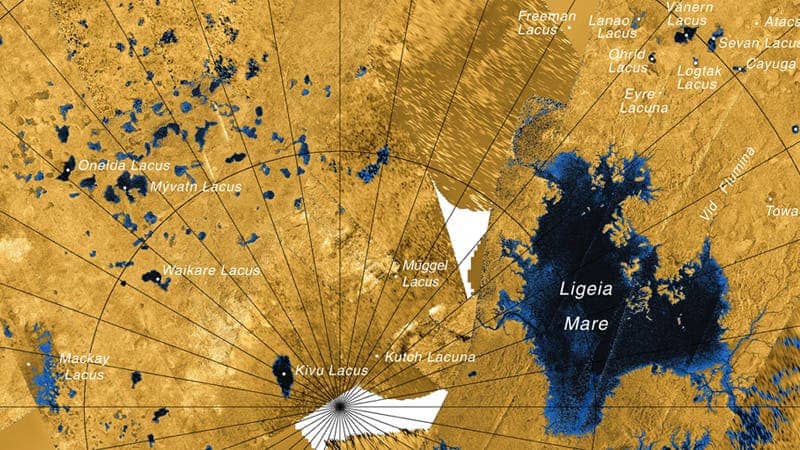Titan’s seas should be deep enough for a robotic submarine to wade through, a new paper explains. This should help pave the way towards our exploration of Titan’s depths.

Fancy a dip? Who doesn’t. But if you ever find yourself on Titan, Saturn’s biggest moon, you should stay away from swimming areas. A new paper reports that the Kraken Mare, the largest body of liquid methane on the moon’s surface is at least 1,000 feet deep near its center, making it both very deep and very cold.
While that may not be very welcoming to humans, such findings help increase our confidence in plans of exploring the moon’s oceans using autonomous submarines. It was previously unknown if Titan’s methane seas were deep enough to allow such a craft to move through.
Faraway seas
“The depth and composition of each of Titan’s seas had already been measured, except for Titan’s largest sea, Kraken Mare—which not only has a great name, but also contains about 80% of the moon’s surface liquids,” said lead author Valerio Poggiali, a research associate at the Cornell Center for Astrophysics and Planetary Science (CCAPS).
Titan is a frozen moon that shines with a golden haze as sunlight glints on its nitrogen-rich atmosphere. Beyond that, however, it looks surprisingly Earth-like with liquid rivers, lakes, and seas sprawling along its surface. But these are not made of water — they’re filled with ultra-cold liquid methane.
The findings are based on data from one of the last Titan flybys made during the Cassini mission (on Aug. 21, 2014). During this flyby, the probe’s radar was aimed at Ligeia Mare, a smaller sea towards the moon’s northern pole. Its goal was to understand the mysterious “Magic Island” that keeps disappearing and then popping back up again.
Its radar altimeter measured the liquid depth at Kraken Mare and Moray Sinus (an estuary on the sea’s northern shore). The authors of the paper, made up of members from both NASA’s Jet Propulsion Laboratory and Cornell University, used this data to map the bathymetry (depth) of the sea. They did this by tracking the return time on the radar’s signal for the liquid’s surface and the sea bottom while taking into account the methane’s effect on the signal (it absorbs some of the energy from the radio wave as it passes through, in essence dampening it to an extent).

According to them, the Moray Sinus is about 280 feet deep, and the Kraken Mare gets progressively deeper towards its center. Here, the sea is too deep for the radar signal to pierce through, so we don’t know its maximum depth. The data also allowed us some insight into the chemical composition of the sea: a mix of ethane and methane, dominated by the latter. This is similar to the chemical composition of Ligeia Mare, Titan’s second-largest sea, the team explains. It might seem inconsequential, but it’s actually a very important piece of information: it suggests that Titan has an Earth-like hydrologic system.
Kraken Mare (‘mare’ is Latin for ‘sea’) is our prime choice for a Titan-scouting submarine due to its size — it is around as large as all five of America’s Great Lakes put together. We also have no idea why this sea doesn’t just evaporate. Sunlight is about 100 times less intense on Titan than Earth, but it’s still enough to make the methane evaporate. According to our calculations, this process should have completely depleted the seas in around 10 million years, but evidently, that didn’t happen. This is yet another mystery our space-faring submarine will try to answer.
“Thanks to our measurements,” he said, “scientists can now infer the density of the liquid with higher precision, and consequently better calibrate the sonar aboard the vessel and understand the sea’s directional flows.”
The paper “The Bathymetry of Moray Sinus at Titan’s Kraken Mare” has been published in the journal Journal of Geophysical Research: Planets.






